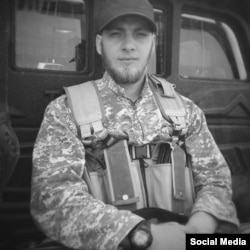All that is known about Islamic State militant Abu Usama Daghestani is how and when he died and what he looked like just before.
Even basic details -- his real name, where he came from in Daghestan, his age -- are all unknown.
On June 13, Abu Usama blew himself up near the barracks of Iraqi security forces in Baiji, one of a deadly team of seven IS suicide bombers.
His real identity is a mystery. But Abu Usama is one of several North Caucasian militants -- exact figures are unknown -- to have been killed in Baiji recently.
He is also one of a growing number of IS militants from the North Caucasus republics of Daghestan, Ingushetia, and Karachai-Cherkessia.
Though Russian-speaking militants in Syria and Iraq are usually lumped together as "Chechens," IS's increasingly powerful North Caucasian contingent is becoming more and more diverse.
The rise in the number of North Caucasians fighting alongside IS comes at the militant group's North Caucasian faction is striving to increase its presence in the Russian Federation.
On June 21, IS formally announced the formation of the Wilayat al- Qawqaz, a "Caucasus Province" that includes Chechnya, Daghestan, Ingushetia, and "Kabika," which likely comprises Kabardino-Balkaria and Karachai-Cherkessia.
At the same time, IS's North Caucasian faction is pushing propaganda designed to influence and recruit would-be militants from the North Caucasus's various republics.
Daghestan
Daghestani militants have become more visible on pro-IS social media, where several have been reported as having been killed fighting alongside IS.
The Daghestani presence in IS-controlled territory has also been boosted by the arrival of two Daghestani preachers and activists, Akhmad Medinsky and Nadir Abu Khalid (Nadir Medetov). Мedinsky first announced his presence in Syria in March, when he appeared in a video alongside two other Daghestanis. According to the Caucasian Knot outlet, Medinsky had studied at the University of Madinah but was dismissed for academic failure.
Medetov swore allegiance to IS leader Abu Bakr al-Baghdadi in a May 23 video.
Another prominent Daghestani preacher, Kamil Abu Sultan ad-Daghestani, has also joined IS.
Medetov and Medinsky have already appeared in several video and audio propaganda addresses intended to recruit more Russian-speaking militants including from Daghestan, while Abu Sultan has posted job advertisements on his Facebook page for physicians to work for IS in Syria or Iraq.
As with all ethnic groups fighting in Syria and Iraq, the exact number of Daghestanis who have traveled to areas under IS control is not known.
Republic of Daghestan head Ramazan Abdulatipov said earlier this month that more than 300 residents of the republic had left to fight alongside IS in Syria.
That figure includes Daghestanis who have been killed, those who are still in Syria, and those who have returned home, Abdulatipov said.
The Daghestani leader called on the authorities to do more to monitor potential IS recruits.
"Young people cannot be allowed to easily and freely travel to Syria or Iraq," Abdulatipov said.
Karachai-Cherkessia
Daghestanis are not the only North Caucasians to become more prominent in IS in recent months. IS's increasingly powerful North Caucasian contingent has also reached out to Karachai-Cherkessia as a source of potential recruits.
Earlier this month, IS released a video in Karachai that featured ethnic Karachai militants, including the increasingly prominent Abu Jihad, a close confidante of IS military commander Umar Shishani who runs IS's official Russian-language media outlet, Furat.
According to Twitter user @sa_borz221, the video is a "propaganda video and a call for jihad."
The number of Karachai militants in IS is unknown. However, the authorities in Karachai-Cherkessia said in June that they had opened criminal cases against 16 residents of the republic suspected of fighting alongside militant groups in Syria. The suspects were aged between 22 and 57 and had all flown at different times from Mineralnye Vody in Stavropol Krai to Istanbul, from where they traveled on to Syria in November 2013. They were allegedly trained in a camp close to the Syrian border town of Atmeh.
Ingushetia
Over the past few months, IS militants identifying as ethnic Ingush have also emerged on Russian-language IS social networks.
Three Ingush militants have been reported on social media as killed since May 2015.
Abu Dudjana Ingushi was killed in the Iraqi town of Baiji in May, while Abu Ramadan Ingushi was reportedly killed near Kobani in Syria in June. Seyfullakh Ingushi also died in May, although the location of his death is not known.
The fact that Abu Dudjana and Abu Ramadan died in two completely different locations indicates that they were almost certainly fighting alongside different North Caucasian battalions within IS, which suggests that IS's Russian-speaking contingent does not necessarily group militants from the same ethnic group together.
Another ethnic Ingush, Abu Dudjana Magas, whose nom de guerre is taken from Ingushetia's capital, has been photographed alongside Chechen IS military commander Abu Umar Grozny.
The number of Ingush who have been recruited to IS is not known. However, in June security authorities in the town of Nazran killed a married couple, Ali and Leyla Aliev, whom they alleged were recruiting militants for IS. Police in Ingushetia also claimed that "tens of young people" had gone to Syria from the republic over the past year, according to the Russian news site Kommersant.





